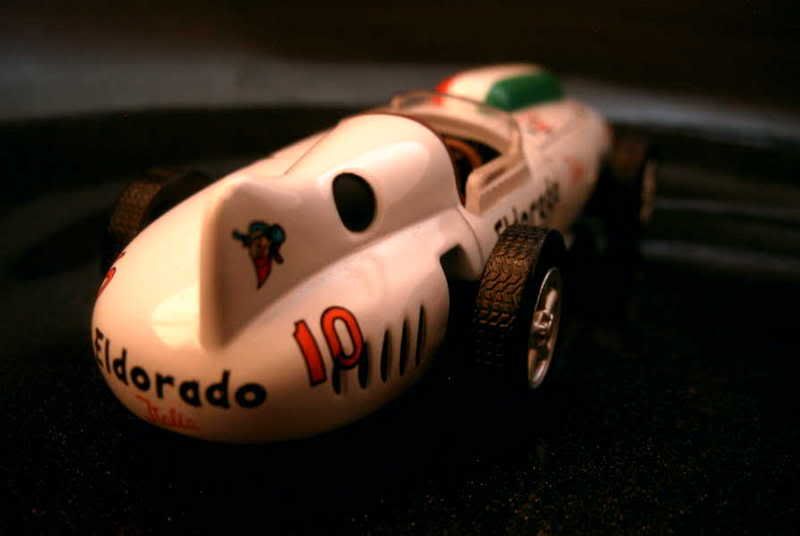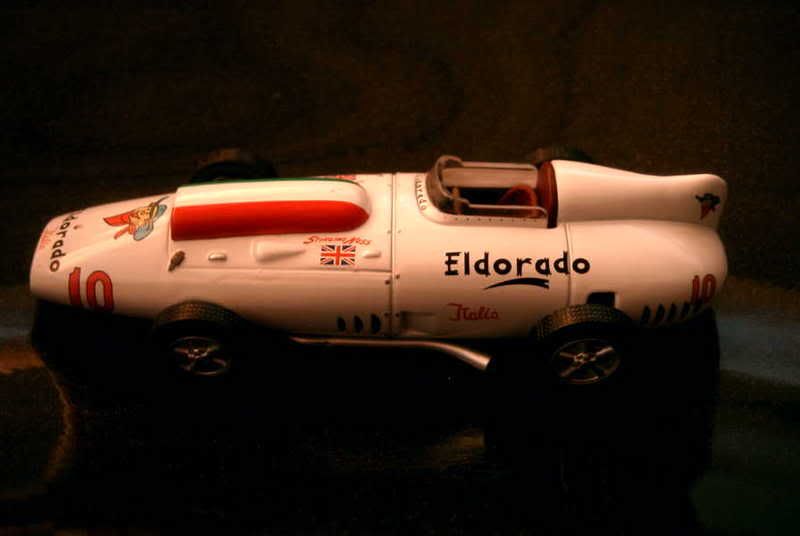A little history
Though a Duesenberg won a Grand Prix during the early Twenties and Indy cars’ specifications closely followed those in use in Europe for a long time, by the Fifties the motor racing scenes on both sides of the Atlantic were totally disconnected. The Indianapolis 500 race had been included by the FIA as part on the World Championship for pilots as early as a Formula One’s crown had been awarded, but to no avail.
In 1957, an attempt was made to reconcile the two drifting aspects of motor racing through the well-named “Race of Two Worlds”, held in Monza. The banked oval had just been thoroughly renovated. The similarity between this circuit and the Indy track begot the tantalizing plan of bringing over American teams, accustomed to this sort of venue, and confront them with entrants from the Old World. A tempting money prize was gathered and a trophy was crafted for the winner of a 500-mile event, ran in three heats.
During its first test an American team demonstrated speeds in excess of those reached at Indianapolis by a hefty 50 kph. Concerns about safety soon arose, and European entrants shied away. The race became a walkover for the American cars, which only real competitors were the three Jaguar D-Types brought by the Ecurie Ecosse, sportscars what were hopelessly slow in an event they were not designed for. Interest was limited for the public and the press reflected the race’s lack of gleam. However, a second Race of Two Worlds was held in 1958, and this time European teams involved themselves a little more to face the American challenge. Though Ferrari’s effort was rather improvised, Jaguar and even more Maserati were well prepared.
Thanks to the sponsoring of Eldorado, a local brand of ice-cream, Maserati was able to develop a specific car for the race. Though this 420 resembled its 250F Formula One, it was a much larger machine, sitting on the same wide Firestone tyres the American teams were using. A potent V8 engine fed with alcohol sat slightly outboard in order to offset the effect of the huge forces pushing the car outwards in the high-speed curves. Stirling Moss was to drive this custom-built monster. Despite being theorically competitive, this too-green Maserati lacked the experience of the American machines, which were used year-round and did not evolve much from one season to the next.
Qualifying no higher than eleventh, Moss nevertheless had a brilliant first heat and finished fourth – the first non-American finisher. In heat two, the Brit battled for the second place for most of the race, but didn’t finish better than fifth, though he once again had the satisfaction of being the first European. During the third and last heat, the Maserati’s steering suddenly broke as Moss was entering a curve at high speed. Out of control the car crashed into the rails, and though its pilot was fine, his race was over… and so was the career of the forgotten Maserati 420, a machine purposely built for an event that would soon die by lack of interest.
About the model
Model: Maserati 420M/58 “Eldorado”
Year: 1958
Event: 1958 Race of Two Worlds, driven by Stirling Moss (retired)
Maker: Grani & Partners
Scale: 1/43
Distributed by: Poligrafici as no.23 of its Maserati press series
Acquired: new with neither box nor stand (probably a production overrun or quality control reject), in December 2006, in Hong Kong, S.A.R.
Though not the best press series I’ve seen in terms of quality, this Poligrafici collection, reserved to the Italian market, was extremely attractive. Its models were often original, and generally well done. I’ll give a 12/20 rating to this one.



Though a Duesenberg won a Grand Prix during the early Twenties and Indy cars’ specifications closely followed those in use in Europe for a long time, by the Fifties the motor racing scenes on both sides of the Atlantic were totally disconnected. The Indianapolis 500 race had been included by the FIA as part on the World Championship for pilots as early as a Formula One’s crown had been awarded, but to no avail.
In 1957, an attempt was made to reconcile the two drifting aspects of motor racing through the well-named “Race of Two Worlds”, held in Monza. The banked oval had just been thoroughly renovated. The similarity between this circuit and the Indy track begot the tantalizing plan of bringing over American teams, accustomed to this sort of venue, and confront them with entrants from the Old World. A tempting money prize was gathered and a trophy was crafted for the winner of a 500-mile event, ran in three heats.
During its first test an American team demonstrated speeds in excess of those reached at Indianapolis by a hefty 50 kph. Concerns about safety soon arose, and European entrants shied away. The race became a walkover for the American cars, which only real competitors were the three Jaguar D-Types brought by the Ecurie Ecosse, sportscars what were hopelessly slow in an event they were not designed for. Interest was limited for the public and the press reflected the race’s lack of gleam. However, a second Race of Two Worlds was held in 1958, and this time European teams involved themselves a little more to face the American challenge. Though Ferrari’s effort was rather improvised, Jaguar and even more Maserati were well prepared.
Thanks to the sponsoring of Eldorado, a local brand of ice-cream, Maserati was able to develop a specific car for the race. Though this 420 resembled its 250F Formula One, it was a much larger machine, sitting on the same wide Firestone tyres the American teams were using. A potent V8 engine fed with alcohol sat slightly outboard in order to offset the effect of the huge forces pushing the car outwards in the high-speed curves. Stirling Moss was to drive this custom-built monster. Despite being theorically competitive, this too-green Maserati lacked the experience of the American machines, which were used year-round and did not evolve much from one season to the next.
Qualifying no higher than eleventh, Moss nevertheless had a brilliant first heat and finished fourth – the first non-American finisher. In heat two, the Brit battled for the second place for most of the race, but didn’t finish better than fifth, though he once again had the satisfaction of being the first European. During the third and last heat, the Maserati’s steering suddenly broke as Moss was entering a curve at high speed. Out of control the car crashed into the rails, and though its pilot was fine, his race was over… and so was the career of the forgotten Maserati 420, a machine purposely built for an event that would soon die by lack of interest.
About the model
Model: Maserati 420M/58 “Eldorado”
Year: 1958
Event: 1958 Race of Two Worlds, driven by Stirling Moss (retired)
Maker: Grani & Partners
Scale: 1/43
Distributed by: Poligrafici as no.23 of its Maserati press series
Acquired: new with neither box nor stand (probably a production overrun or quality control reject), in December 2006, in Hong Kong, S.A.R.
Though not the best press series I’ve seen in terms of quality, this Poligrafici collection, reserved to the Italian market, was extremely attractive. Its models were often original, and generally well done. I’ll give a 12/20 rating to this one.






8 comments:
I didn´t know who was the driver.
This car is wonderful. The rest of the F1´s haven´t any ornament.
This is true that this kind of decoration for the European car of the Fifties is rather unusual.
Very nice model, Lorenzo721...
This one was unknowned to me.
Thanks for sharing with us.
its huge!! nevertheless, its a race car and it has some history and character, and i love it! thanks for the pic and info sir Laurent! :-)
Thanks José António, nice to know you've discovered something!
Mike, yes it's true that it's very big, which doesn't really make it an elegant car... Thanks for your comments!
Did not know this model. Really is very interesting and beautiful.
It indeed seems that there's something about this car, as it can be judged from the number of comments its model has already received!
Post a Comment